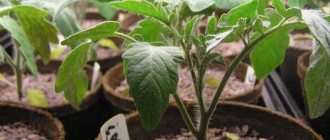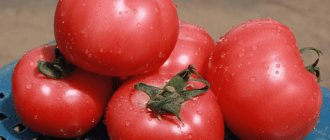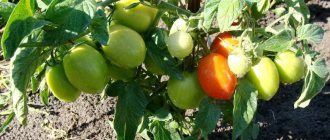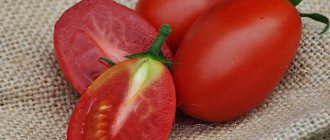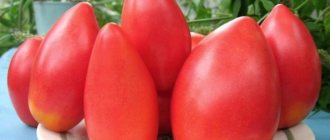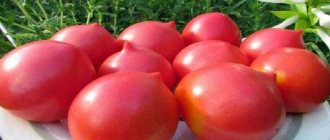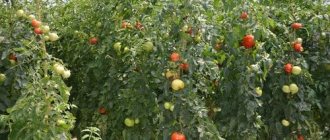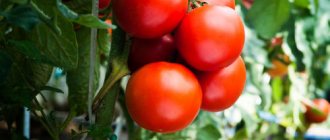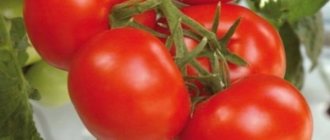The Esmira F1 tomato is one of the high-quality, high-yielding hybrids with early ripening that entrepreneurs like. But they can be grown under film for ordinary gardeners to get delicious salad vegetables or to make winter preparations.
| Height | Landing location | Ripening time | Fruit color | Fruit size | Origin | Fruit shape |
| Tall | Greenhouse | Early ripening | Pink | Average | Hybrid | Round |
Description and characteristics of the variety
The Esmira F1 tomato was created by specialists from the Dutch company Rijkz Zwaan. This is an indeterminate hybrid with very short internodes, allowing the bush to set more clusters - up to 10-11 pieces. The height reaches 1.8 m. It branches slightly, the leaves are small, the inflorescences are intermediate. One brush produces 4-6 tomatoes. They ripen 90-100 days after the seeds sprout.
The fruits are large on the lower clusters (300-350 g each), on the middle and upper clusters - 190-220 g each. There is slight ribbing, a ripe tomato is pink in color, round, slightly flattened. The pulp is dense and fleshy, there are few seeds in it.
There is no point in collecting seeds; in hybrids they do not retain varietal properties, so you need to buy them from the manufacturer.
The hybrid is considered a salad variety, but smaller fruits can be canned, the rest can be used to prepare various dishes, salted, and processed into pastes.
Agricultural technology varieties
Tomatoes of this variety can be grown both in open ground and in a greenhouse. A prerequisite for obtaining a good harvest is correct agricultural technology.
- To obtain an early harvest of Esmira F1 tomatoes, seeds are sown for seedlings at the end of February. The seeds of the hybrid have already been treated with antifungal drugs, so they do not need to be kept in potassium permanganate for dressing. You can soak the seed material in a solution of potassium permanganate or in aloe juice for 10-12 hours.
- Correct selection of soil for seedlings is the key to friendly, healthy seedlings and good development of seedlings. It is better to use ready-made soil mixtures from the store, but you can also prepare the soil yourself. To do this, you need to take 2 kg of peat and sand and one kilogram of ash flour per bucket of sifted humus. Mix everything thoroughly. Be sure to warm the soil in the room where the seeds will be sown for about 3-5 days.
- Seedlings will appear 3-4 days after sowing; they should be carefully watered with warm water and potassium permanganate (weak solution). It is better to water with a flower sprayer. Watering is carried out as the top layer of soil dries.
See also
Description of the Pablo tomato variety, yield and cultivationRead
- Compliance with the irrigation and lighting regime is as important as maintaining optimal humidity (indoor air humidity no higher than 65%, temperature 22 degrees, and light 18 hours a day).
- While the real leaves appear, the seedlings can be sprinkled with soil mixture.
- Seedlings need to be plucked after the appearance of 2-4 true leaves at a distance of 10x10 for better development of the stem and root system of the seedlings.
- The pick grows for about a month to 25-30 centimeters; this is the height of the seedlings that is optimal for planting in the beds.
- A week before planting the seedlings, they are treated with a solution of Bordeaux mixture.
- After planting in the beds, the plants need to be regularly watered, ventilated (in a greenhouse) and fertilized with nitrogen and potassium fertilizers according to the schedule. The first fertilizing is nitrogen, then potassium. Fertilizers should be carried out together with watering and, first, preferably with liquid fertilizers.
- It should be remembered that tomatoes do not need to be sprayed during fruit set and ripening.
Advantages and disadvantages
Esmira is able to compete with the most famous large tomatoes. She has a number of positive qualities. This:
- Unique sugar taste with a pleasant aroma;
- Soft juicy pulp;
- Unpretentious care;
- Disease resistance;
- Easy to grow;
- Large large fruits;
- High yield.
No disadvantages were identified in the described variety.
Esmira F1 tomato seeds indet. ultra-early 105 days env. 190-220g roses. (Rijk Zwaan)
Order by phone
- +38 ( 050 ) 699-12-64
- +38 ( 066 ) 827-50-68
- +38 ( 066 ) 827-50-68
- +38 ( 067 ) 771-68-61
- +38 ( 068 ) 347-43-44
- +38 ( 097 ) 058-95-54
- +38 ( 093 ) 348-47-82
- +38 ( 063 ) 238-93-97
Important
No minimum order amount! But prepayments are required:
- for orders up to 200 UAH;
- for goods to order - 100% prepayment;
- Each order contains a gift.
Delivery methods
Every day:
- Nova Poshta
- Ukrposhta
- Autolux
For order values over 2,500 UAH and weight up to 500 grams, delivery is free (from 12/15/2018)
Discounts
When ordering for 3,000 UAH - 3% discount, 5,000 UAH - 5% discount, 10,000 - 10% discount
Discounts cannot be combined!
Receive gifts by ordering online
Each customer who places an order online (by registering in the store and making purchases through the basket) receives a magazine, a package of seeds and a calendar as a gift (included in the order from September to January).
Contacts for placing an order in the ATO zone
We accept orders for vegetable seeds from the ATO zone
Telephone: 066 061 04 03
Tomato Esmira F1 description:
A very early hybrid of pink-fruited tomato of indeterminate type.
The growing season is 105 days.
Early fruiting begins, the fruits are dense, 220-300 g, do not crack, there are no green shoulders, the fruits are bright pink.
Concentrated early harvest returns.
The plant is compact, open, internodes are very short.
Can be grown spring-summer and summer-autumn.
When controlling the microclimate conditions in the greenhouse, with timely and complete application of mineral fertilizers, this hybrid shows higher indicators of fruit size.
Pink tomato Esmira F1 is grown in all regions of Ukraine.
HR: ToMV: 0‒2/Ff: AE/Fol: 0.1/Sbl/Va: 0/Vd: 0
What does the crop look like in the field:
What the original packaging looks like:
Tomato Esmira F1 is a participant in the following ratings and reviews in Seed Supermarket magazines:
– review of popular pink indeterminate tomatoes from the Seeds Supermarket Magazine No. 4 “Autumn 2015 - Winter 2016”, p. 13.
– review of the best pink tomatoes in greenhouses from Seed Supermarket Magazine No. 7 “Autumn 2016” page No. 34.
Tomato seeds Esmira F1 (Rijk Zwaan) can be in two types of packaging:
– original packaging (from the manufacturer)
– Seed Supermarket packaging.
If you only need seeds in original packaging, please indicate this in the comments to your order or tell the sales consultant this when placing your order by phone.
The manufacturer reserves the right to change the packaging design, color and availability of seed treatment.
If this item does not have a package with a suitable number of seeds, please inform our sales manager - he will try to help you open the package or offer a suitable analogue.
Tomato Supermodel
In 2012, Altai breeders developed a very interesting variety, and then it was registered in the State Register. It’s not for nothing that this graceful bush with delicious fruits was called the Supermodel. This is one of the best low-growing tomato varieties for the southern regions of Russia and the middle zone. It will bear fruit in Altai, Tatarstan, and the Volga region. Not recommended for Siberia and the Far East.
Description of the variety, characteristics
Determinate variety, mid-early ripening, intended for open ground. Despite the fact that the bush does not grow higher than 70 cm, it needs a garter. Removing stepsons up to the first cluster will increase the yield of the bush.
The largest harvest is formed on a plant formed in 2-3 shoots. The small leaves are dark green and provide the entire crop with the necessary nutrition.
The elongated fruits, up to 15 cm in size, are smooth and even, collected in graceful clusters. The first fruits can be harvested 100-120 days after sowing.
The weight of one pink-red tomato can reach 100g. They are meaty and have good flavor. Two to three chambered fruits contain 5-6% dry matter.
Suitable for fresh use, canning, good after cooking - in sauces and main dishes. They can be salted or dried. With the best care, you can collect no more than 8 kg of ripe fruits from the bush.
Features of cultivation and care
Grow like most tomatoes. Seeds for seedlings are sown 55-60 days before planting in open ground. There are no more than 3-4 plants per 1 m2 of beds.
Bushes that have taken root outdoors are undemanding in care and resistant to brown spot and fruit cracking. They are immune to many diseases, but can be affected by tomato blight.
If diseased fruits appear, you need to remove them immediately and spray the plants with Hom.
Advantages and disadvantages
Many gardeners have already identified the main pros and cons of this hybrid.
The advantages of a Supermodel include the following qualities:
- beautiful appearance
- high taste qualities
- unpretentiousness and strong immunity
- tomatoes tolerate transportation and long-term storage well
- universal use, both fresh and prepared
- unpretentiousness to the soil.
The obvious disadvantages are:
- average yield
- moodiness towards sunlight
- demanding for watering and timely application of fertilizers.
Tomato Esmira, the most generative of the pink fruits
One of the leading commercial hybrids, one of the well-known among large producers, greenhouse growers and gardeners. The most generative early hybrid, with incredible productivity, difficult agricultural technology for beginners - the Esmira tomato has become a worthy competitor to the leading industrial forms. He planted it and remembered when to harvest – it’s not about him.
Intensive crop for professional cultivation (official definition). What is interesting to the farmer, what will please collectors and summer residents: information from the originator, opinions, agricultural technology, assessment of prospects.
Tomato Esmira: brief information
Tomato Esmira F1 hybrid form from the Dutch company Rijk Zwaan. Included in the State Register of the Russian Federation in 2012, the admission zone is all regions.
Recommended by the originator for cultivation in protected soil conditions - for heated greenhouses, for a short cycle, possibly for a second rotation.
It is successfully cultivated in heated glass greenhouses, polycarbonate, film, light greenhouses, tunnels, on artificial substrate, where it reveals its full economic value.
With professional maintenance and compliance with microclimate requirements, it is sometimes used in small-volume production.
Tomato Esmira F1: what a farmer and summer resident need to know about the Dutch hybrid. Review, assessment of prospects and productivity, subtleties of agricultural technology.
On an experimental basis, cultivation in open ground is possible, but the characteristics inherent to the form (bush height, ripening time, productivity) will be different.
Ripening period - early.
The yield of Esmira tomato is declared to be about 3.5 kg/m2. Numbers are announced from 10-12 kg/m2 to 30 kg/m2 and higher, incl. in extended circulation.
In warm climates (6 hour zone), results of up to 40 kg/m2 on artificial substrates (mineral wool) have been reported. On average it is from 4.5 to 8.5 kg/m2. The variation is large, but depends on the growing strategy.
Characteristics of tomato, description
The indeterminate form belongs to the early hybrids of the intensive type, the beef category. Briefly and succinctly: the characteristics declared by the originator, descriptions from farmers and gardeners.
- The bush is of a generative type, compact, according to experts, comparable to semi-indeterminate plants, up to 180 cm.
- Stems with short internodes, high tying potential: bears up to 10-12 clusters (up to 5-6 berries each).
- The fruits are round in shape with slight ribbing, slightly flattened at the poles.
- At technical ripeness, rich pink color without a green spot at the stalk, large - average weight 190-210 g, larger on the first clusters, resistant to cracking.
- The fruit is multi-chambered (4-6 pieces). There are no very large berries, they don’t get smaller: better quality – one-dimensionality. The skin is thin and strong, the flesh is dense, excellent transportability and keeping quality.
- Salad type, with a true tomato taste. Sweet and sour, the flesh is juicy but not watery.
- It is used fresh, but, according to reviews, it is also good for canning, as pickling, for juice and sauce.
Resistant to major crop diseases, not prone to blossom end rot.
And the most interesting thing: agricultural technology for growing Esmira tomatoes, 9 rules and two subtleties
Tomato Esmira F1 and everything about it: data declared by the originator, opinions of farmers. And most importantly: agricultural technology.
- The placement density is no more than 2.5-3 plants per m2.
- The planting pattern used is single-row method 80 x 30, double-row 30 x 40 x 90 and similar.
- Reducing the feeding area with a planting pattern of less than 20 cm between bushes - thickening, leading to a lack of light and competition, is unacceptable.
- It forms into one stem, needs a balance of generative mass, does not tolerate turning into a “standard palm” with excessive leaf breakage.
- Needs stimulation of the vegetative mass for abundant fruiting and maintaining balance.
- This is especially true before the formation of the third cluster, when the task is to balance early fruit formation and vegetative mass.
- That is why, according to experts, fertilizing begins after the formation of the second cluster: so as not to “disperse” the vegetative mass to the detriment of filling.
- When working with leaves for the hot period of the year, it is recommended to leave at least 16 leaves and at least two in stock when growing about 8 brushes: the leaves regulate cooling.
- If growth vigor is insufficient, it is recommended to increase the content of calcium nitrate in fertilizing and increase watering.
According to reviews, early removal of the tops (pinching) after the fourth brush contributes to earlier harvesting times.
A plant is considered balanced if in the 4-5 raceme phase the distance from the growing point to the flowering raceme varies within 10-12 cm.
Reviews
Vegetable growers who have been growing the still young hybrid for more than 10 years agree: the Esmira tomato is unique, and the reviews about it are appropriate.
Early (even if not the most), but suitable for the first revolution, extended. In the south it is grown for off-season production; it has performed well on artificial substrate.
According to reviews, experience of use in low-volume production is possible.
Tomato 'Grotto'
Main genus: Tomato
| Size |
| Productivity |
| Ripening period |
| Soil type |
| Growing method |
| Purpose of fruits |
| Disease resistance |
| Soil ph requirements |
| Life form |
| Shape of fruits/stems/roots and tubers/heads |
| Size of fruits/stems/roots and tubers/heads |
| Cultivation region by origin |
| Vitamin content |
| Color of fruits/roots and tubers |
| Peel thickness |
| Frost resistance |
| Drought resistance |
| Decorative value |
| Taste of fruits |
| Shelter for the winter |
| Pest resistance |
| Habit |
| Keeping quality |
| Parthenocarpic |
| Branching pattern |
| Density and character of the pulp |
Expand all properties
Description of the plant:
Tomato 'Grotto' is a variety bred by the All-Russian Research Institute for Selection and Seed Production of Vegetable Crops. Approved for use in the Volga-Vyatka region in 1994.
Recommended for growing in open ground.
Dimensions and growth form:
The 'Grotto' variety is represented by non-standard, determinate, erect plants, 35–40 cm high. The foliage and branching are moderate. The leaf is ordinary, large, light green, glossy. The surface is slightly corrugated.
The inflorescence is simple, compact. The first inflorescence is laid above the 6–7th leaf, subsequent ones - after 1–2 leaves or without division. Pedicel with articulation.
Fruit:
Size, shape and color:
The fruit is round, weighing 49–52 g. The surface is smooth. The color of the unripe fruit is green with a dark spot at the stalk, while the mature fruit is red. Number of nests 2–3.
The taste of fresh, canned and salted fruits is good.
Ripening time and yield:
Tomato 'Grotto' is an early ripening variety (early ripening). Fruit ripening occurs on the 109–118th day after full germination. The marketable yield is stable and amounts to 3.4–5.6 kg/m2.
Disease resistance:
The variety is slightly affected by blossom end rot. It is quite damaged by late blight, septoria and macrosporiosis. Susceptibility to bacterial black spot is average (with severe development of the disease).
Directions for use:
Recommended for fresh consumption, for whole-fruit canning and pickling.
For open ground
Varieties of low-growing tomatoes for open ground can also be divided into several categories and the best are ready for consideration:
Early large-fruited
“Myrsini F1”
The tomato plant has a very large leaf that will protect the fruits from the scorching sun. The smooth-skinned, heart-shaped tomato has a medium to intense body. A bright red tomato has 6 chambers, sometimes more. Weight up to 230 g, excellent taste and excellent transportability. The plant is resistant to a range of diseases.
"Simona F1"
Over 10 years on the market it has become a favorite for many vegetable growers. The flat-round tomato has light ribs, is dense and does not crack under any conditions. Red with four nests, weighing up to 300 g and excellent taste.
"Three Bears F1"
It is difficult for a small bush to hold fruits of 250 g each, so it requires a garter. The tomatoes are round, dense, slightly ribbed, with 6 cavities and a wonderful taste
"Ivanhoe F1"
Flat-round fruits weighing up to 350 g have 6 or more nested formations. Tomatoes of this variety have an excellent taste and a beautiful, even, pink color.
Medium size
If you are looking for low-growing tomatoes for open ground, ones that can be preserved, juice or sauce can be prepared, then you can consider the following:
"Roseanne F1"
The plant is so productive that it cannot independently, without fixation, hold a marketable crop of fruit. Early with medium leaves and rounded fruits with light ribbing and medium density. The tomato is pink in color with nests from 4 to 6 and weighing up to 150 g. The excellent taste will delight even a gourmet. And the high marketability and resistance to cracking will make you fall in love with the variety and cultivate it constantly.
"Globe F1"
The variety is suitable for pickling and salads. A small leaf will allow you to be well heated by the sun. The fruit is flat-round, red, with a weak rib, 4 lobes and weighs up to 120. The taste, according to tasters, is good.
Sustainable and productive
Good tomatoes for open ground, low-growing and very disease-resistant, can be represented by the following:
"Gavroche"
The height of the bushes will not be higher than 50 cm, and the variety will produce fruits already on the 83-85th day after germination. The variety can be easily distinguished by its slightly corrugated leaf. The fruit of a classic red tomato weighs up to 50 g. Fruiting is very friendly, and the tomatoes are tasty both fresh and canned.
"Yard"
Cuboidal, red tomato, weighing up to 110 g with slight ribbing and good density. The tomato taste is excellent, 3-4 nests. Suitable for both fresh consumption and preservation.
The plant is not very powerful, the shoots cannot support a huge harvest on their own and need to be taken care of by staking and shaping.
